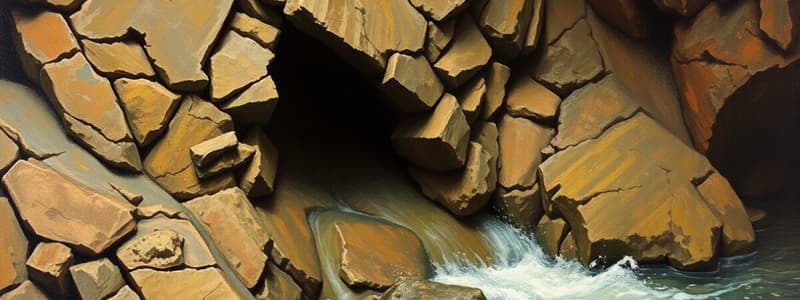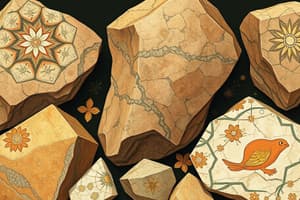Podcast
Questions and Answers
What type of rock is formed from the cooling and solidification of magma or lava?
What type of rock is formed from the cooling and solidification of magma or lava?
- Metamorphic Rocks
- Foliated Rocks
- Igneous Rocks (correct)
- Sedimentary Rocks
Clastic sedimentary rocks are formed from the chemical alteration of minerals.
Clastic sedimentary rocks are formed from the chemical alteration of minerals.
False (B)
What is the main source of pressure that affects rock formation?
What is the main source of pressure that affects rock formation?
Weight of overlying rocks or tectonic activity
The process of ________ involves breaking rocks into smaller pieces without changing their chemical composition.
The process of ________ involves breaking rocks into smaller pieces without changing their chemical composition.
Match the type of metamorphic rock with its description.
Match the type of metamorphic rock with its description.
Which rock is an example of an intrusive igneous rock?
Which rock is an example of an intrusive igneous rock?
Sedimentary rocks are formed only through volcanic activity.
Sedimentary rocks are formed only through volcanic activity.
What are the two main processes involved in sediment formation?
What are the two main processes involved in sediment formation?
Rocks that melt into magma due to extreme heat can be found near __________.
Rocks that melt into magma due to extreme heat can be found near __________.
Match each weathering type with its description.
Match each weathering type with its description.
Which type of sedimentary rock is formed from plant or animal remains?
Which type of sedimentary rock is formed from plant or animal remains?
Intrusive igneous rocks cool quickly on the surface.
Intrusive igneous rocks cool quickly on the surface.
What is the role of pressure in the formation of metamorphic rocks?
What is the role of pressure in the formation of metamorphic rocks?
The process of __________ involves the transfer of weathered material to new locations.
The process of __________ involves the transfer of weathered material to new locations.
Match the following igneous rocks with their cooling rates:
Match the following igneous rocks with their cooling rates:
Which of the following processes is NOT involved in the formation of sedimentary rocks?
Which of the following processes is NOT involved in the formation of sedimentary rocks?
Metamorphic rocks can be formed from either igneous or sedimentary rocks.
Metamorphic rocks can be formed from either igneous or sedimentary rocks.
What is an example of a clastic sedimentary rock?
What is an example of a clastic sedimentary rock?
Metamorphic rocks with a layered texture are referred to as __________.
Metamorphic rocks with a layered texture are referred to as __________.
Which of the following is a primary agent of erosion?
Which of the following is a primary agent of erosion?
Flashcards
Igneous Rocks
Igneous Rocks
Rocks formed when magma or lava cools and solidifies. Intrusive igneous rocks cool slowly beneath the Earth's surface, forming large crystals (e.g., granite). Extrusive igneous rocks cool quickly on the surface, resulting in small crystals or glassy textures (e.g., basalt, obsidian).
Sedimentary Rocks
Sedimentary Rocks
Rocks formed from the accumulation, compaction, and cementation of sediments. Sediments can be fragments of other rocks (clastic), dissolved minerals (chemical), or plant/animal remains (organic).
Metamorphic Rocks
Metamorphic Rocks
Rocks formed when existing rocks undergo intense heat and pressure. The heat causes recrystallization and the formation of new minerals, while the pressure can create layered (foliated) or non-layered (non-foliated) textures.
Weathering
Weathering
Signup and view all the flashcards
Erosion
Erosion
Signup and view all the flashcards
Compaction
Compaction
Signup and view all the flashcards
Cementation
Cementation
Signup and view all the flashcards
Melting
Melting
Signup and view all the flashcards
Cooling
Cooling
Signup and view all the flashcards
Heat in the Rock Cycle
Heat in the Rock Cycle
Signup and view all the flashcards
How are igneous rocks formed?
How are igneous rocks formed?
Signup and view all the flashcards
What is the key process in forming sedimentary rocks?
What is the key process in forming sedimentary rocks?
Signup and view all the flashcards
What causes the transformation of rocks into metamorphic rocks?
What causes the transformation of rocks into metamorphic rocks?
Signup and view all the flashcards
What is mechanical weathering?
What is mechanical weathering?
Signup and view all the flashcards
What is chemical weathering?
What is chemical weathering?
Signup and view all the flashcards
What is erosion?
What is erosion?
Signup and view all the flashcards
What is compaction?
What is compaction?
Signup and view all the flashcards
What is cementation?
What is cementation?
Signup and view all the flashcards
What happens to rocks when they experience extreme heat?
What happens to rocks when they experience extreme heat?
Signup and view all the flashcards
What determines the texture of igneous rocks?
What determines the texture of igneous rocks?
Signup and view all the flashcards
Study Notes
Igneous Rocks
- Formed by the cooling and solidification of magma or lava
- Intrusive igneous rocks cool slowly beneath the surface, forming large crystals (e.g., granite)
- Extrusive igneous rocks cool rapidly on the surface, forming small crystals or a glassy texture (e.g., basalt)
Sedimentary Rocks
- Formed from the accumulation and transformation of sediments through weathering, erosion, deposition, compaction, and cementation
- Clastic sedimentary rocks form from fragments of other rocks (e.g., sandstone)
- Chemical sedimentary rocks form from dissolved minerals (e.g., limestone)
- Organic sedimentary rocks form from plant and animal remains (e.g., coal)
Metamorphic Rocks
- Formed when existing rocks undergo changes in temperature and pressure
- Foliated metamorphic rocks have a layered texture (e.g., slate, schist)
- Non-foliated metamorphic rocks do not have a layered texture (e.g., marble, quartzite)
Heat and Pressure in Rock Formation
- Heat from magma or geothermal energy causes recrystallization and mineral formation
- Pressure from overlying rocks or tectonic activity compresses rocks, aligns minerals, and creates new textures
Weathering and Erosion
- Weathering breaks down rocks into smaller pieces via mechanical or chemical processes
- Mechanical weathering physically breaks rocks (e.g., frost wedging, abrasion)
- Chemical weathering alters rock composition (e.g., oxidation, carbonation)
- Erosion moves weathered materials to new locations by agents like water, wind, ice, and gravity
Compaction and Cementation
- Compaction reduces the volume of sediments due to the weight above
- Cementation binds sediments together to form a rock with dissolved minerals
Cooling and Melting
- Slow cooling results in large crystals in the resulting rock
- Rapid cooling produces small crystals or glassy textures (e.g., obsidian)
- Rocks melt into magma under extreme heat, such as near subduction zones or hotspots
Studying That Suits You
Use AI to generate personalized quizzes and flashcards to suit your learning preferences.




